
The Navy Department Library
Joseph Hewes (APA22), Edward Rutledge (APA24), Hugh L. Scott (AP43), Tasker H. Bliss (AP42) & Electra (AKA4) - War Damage Report No. 32
Transports Torpedoed Off Fedela, 11-15 November 1942
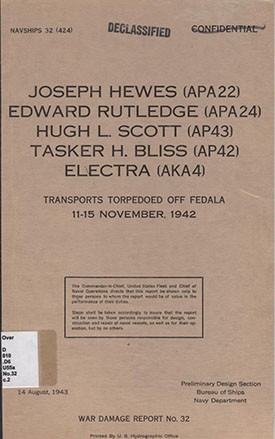
NAVSHIPS 32 (424)
CONFIDENTIAL
Joseph Hewes (APA22)
Edward Rutledge (APA24)
Hugh L. Scott (AP43)
Tasker H. Bliss (AP42)
Electra (AKA4)
Transports Torpedoed Off Fedala
11-15 November 1942
The Commander-in-Chief, United States Fleet and Chief of Naval Operations directs that this report be shown only to those persons to whom the report would be of value in the performance of their duties.
Steps shall be taken accordingly to insure that the report will be seen by those persons responsible for design, construction and repair of naval vessels, as well as for their operation, but by no others.
Preliminary Design Section
Bureau of Ships
Navy Department
14 August, 1943
WAR DAMAGE REPORT No. 32
Printed By U. S. Hydrographic Office
Transports Torpedoed off Fedala
11-15 November 1942
JOSEPH HEWES (APA22)
EDWARD RUTLEDGE (APA24)
HUGH L. SCOTT (AP43)
TASKER H. BLISS (AP22)
ELECTRA (AKA4)
References:
(a) CTF 34 Material report 00243, 27 November 1942.
(b) C.O. JOSEPH HEWES, Action report dated 16 November 1942.
(c) C.O. EDWARD RUTLEDGE, War Diary.
(d) C.O. EDWARD RUTLEDGE ltr. to SecNav of 23 November 1942.
(e) C.O. HUGH L. SCOTT - AP77/A16-3 of 16 November 1942.
(f) C.O. TASKER H. BLISS - AP42/A16-3 - Action Report dated 15 November 1942.
(g) C.O. TASKER H. BLISS - AP42/A16-3(110) - Report of Loss dated 24 November 1942.
(h) C.O. ELECTRA - Serial 048 - of 17 November 1942.
(i) C.O. RAVEN - Serial 002 - of 17 November 1942.
(j) C.O. ELECTRA - A7-3/AKA/L11-1/(017) of 22 June 1943.
CONTENTS
| Page | |
| JOSEPH HEWES | 1 |
| EDWARD RUTLEDGE | 1 |
| HUGH L. SCOTT | 2 |
| TASKER H. BLISS | 3 |
| ELECTRA | 4 |
| DISCUSSION | 7 |
PHOTOGRAPHS
1. U.S.S. ELECTRA - port side looking forward and showing the small patches over fragment holes.
2. U.S.S. ELECTRA - starboard side looking forward and showing the outside of the large patch over the torpedo hole.
3. U.S.S. ELECTRA - looking forward and to starboard at the inside of the patch over the torpedo hole.
4. U.S.S. ELECTRA - looking forward and to starboard at the shoring for the large patch. Fragment damage to the third deck in way of the hit is also visible.
PLATES
I - JOSEPH HEWES - Probable Flooding Directly from Damage
II - EDWARD RUTLEDGE - Probable Flooding Directly from Damage
III - HUGH L. SCOTT - Probable Flooding Directly from Damage
IV - TASKER H. BLISS - Probable Flooding Directly from Damage
V - ELECTRA - Loading and Flooding
JOSEPH HEWES (APA22)
(Plate I)
| Former Name | EXCALIBUR | Length (w.l.) | 450 ft. |
| Year Built | 1931 | 61'6" | |
| Displacement | 14,100 Tons | Mean Draft | 26'4" |
1. JOSEPH HEWES was anchored off Fedala, French Morocco on 11 November, 1942 in 26 fathoms with 75 fathoms of chain to her port anchor. The ship was in material condition ABLE except for doors and hatches in holds which were being worked (holds Nos. 1, 2, 3 and 6). At 1950 a torpedo was observed passing ahead from the port side, and General Quarters was sounded.
2. Immediately following the torpedo observed, a second torpedo struck the ship on the port side in No. 2 hold near the forward bulkhead and about 10 to 15 feet below the waterline. The explosion apparently ruptured both the forward and after bulkheads of No. 2 hold filling No. 1 and No. 2 holds immediately and No. 3 hold more slowly. The Commanding Officer attempted to slip the anchor chain and back the ship onto the beach, but the excessive trim by the bow placed the forecastle under water and backing the engines did no good as the propeller was out of water.
3. All pumps were started but water continued to rise and the ship continued to settle by the bow. Fireroom and engine room personnel secured auxiliary machinery and took measures to reduce steam pressure when it became apparent that nothing could be done, and the order was given to abandon ship. The ship sank at about 2032, 11 November, 1942.
EDWARD RUTLEDGE (APA24)
(Plate II)
| Former Name | EXETER | Length (w.l.) | 450 ft. |
| Year Built | 1931 | Beam | 61'6" |
| Displacement | 14,110 Tons | Mean Draft | 26'4" |
4. On Thursday evening, 12 November, 1942, U.S.S. RUTLEDGE was at anchor in the transport area off Fedala, French Morocco, riding to the port anchor in 23 fathoms of water with 60 fathoms of chain. At about 1731 she was struck by one torpedo on the starboard side near the bulkhead between the fireroom and the engine room, and a few seconds later a second torpedo struck the starboard side near No. 6 cargo hold. The first torpedo caused heavy black smoke to pour out of the stack, and steam was observed escaping from the engine room hatch. The second explosion shook the ship more severely than the first, and debris of all kinds was thrown in the air higher than the mainmast. No fires were started by the torpedo; or, if any had been started, they were immediately put out by the flooding.
--1--
5. The ship immediately took a decided list to starboard and began to sink rapidly by the stern. In less than 30 seconds the fireroom flooded with oil and water to a level at least four feet above the floor plates, and within five minutes the stern of the ship had settled so that the deck beading aft was not more than three feet above the water. The anchor chain was slipped and the ship was allowed to drift toward the beach with the wind and tide.
6. No. 6 hold filled and the main deck aft was soon awash, the list gradually decreasing to not more than 3° as the ship settled. She remained with her stern awash for some time and then began to sink slowly until the rudder apparently hit bottom. She then slowly turned over to starboard, the stern coming up and the bow going down until the keel was practically level with the water. The ship slid under and disappeared at 1848, approximately 1-3/4 hours after the torpedoing.
HUGH L. SCOTT (AP43)
(Plate III)
| Former Names: HAWKEYE STATE PRESIDENT PIERCE |
Length (w.l.) | 535 ft. |
| Year Built 1921 | Beam | 72 ft. |
| Displacement 21,167 Tons | Mean Draft | 30'6" |
7. There is no information available on the condition of the ship at the time she was attacked. It is known, however, that she was engaged in unloading cargo to the beach at Fedala on 12 November, 1942. At 1732, 12 November, about one minute after the first torpedo hit EDWARD RUTLEDGE, two torpedoes hit SCOTT on the starboard side. There was an appreciable interval (about 10 seconds) between the two explosions. The first torpedo apparently struck the starboard side abreast No. 1 fireroom, and the second probably hit in the engine room. The ship appeared to lift and then immediately listed about 30° to starboard and began to settle aft. All power, lighting and communication went out with the first hit and no auxiliary lighting was available, resulting in complete darkness.
8. The explosions wrecked all starboard Welin Davits and blew one cross beam up onto the sun deck. It was reported that wooden bulkheads throughout the ship collapsed (reference (c)).
9. The first torpedo wrecked the galley and mess hall on "D" deck immediately above the firerooms. It also caused the cabin and adjacent rooms under the bridge structure to collapse, apparently from the weight of plastic protection installed above them. Large quantities of fuel oil flowed out on the water on the starboard side.
10. There was no difficulty from fire, but there was apparently a fire for a brief period immediately following the first explosion. The Executive Officer, who was on the port side of "C" deck just forward of the uptakes, reported
--2--
that there was a glow of short duration just abaft the uptakes following the first hit. He walked aft to this area and encountered flames coming from the starboard passageway between the uptakes and staterooms. He observed that bulkheads and decks in this area were spotted with oil and that the staircase down to "E" deck seemed to be sagging. The second explosion then seemed to occur in the engine room, about 30 feet aft of him, and this explosion put the fires out, bringing darkness and preventing any further inspection. He reported passing twice along the port passageway next to the uptakes and that he got blisters on his hands from fires in the uptakes.
11. When it became apparent that nothing could be done to save the ship, the Commanding Officer ordered the ship abandoned. Boats continued in the vicinity of the ship until about 2030. At this time the ship was still afloat, but she sank some time later during the night.
TASKER H. BLISS (AP42)
(Plate IV)
| Former Names: GOLDEN STATE PRESIDENT CLEVELAND |
Length (o.a.) | 535 ft. |
| Year Built 1921 | Beam | 72 ft. |
| Displacement 21,167 Tons | Draft | 30'6" |
Narrative
12. On the evening of 12 November, 1942, TASKER H. BLISS was anchored in 25 fathoms of water off Fedala, French Morocco, with 45 fathoms of chain to the starboard anchor. The ship was unloading to the beach with all boilers on the line and engines ready for immediate use. Her material condition was not reported. Shortly after the torpedoing of RUTLEDGE and SCOTT at 1732, TASKER H. BLISS was hit simultaneously on the starboard side by two torpedoes. One hit in the after corner of No. 1 fireroom and the other hit between the engine room and No. 6 hold, resulting in complete darkness. It is to be noted that this is almost identical with the torpedoing of HUGH L. SCOTT. Flames, smoke, oil, water and debris were thrown up abreast the stack and came down over the ship as far forward as the end of the upper deck. The ship heeled sharply to port, then rolled to starboard about 40° and finally settled on a list of about 200 to starboard. Large quantities of oil flowed out on the sea on the starboard side. The ship was ordered abandoned over the port (high) side. Within about 15 minutes all hands were off the ship except for a few officers. Fires were started by the hits and could not be controlled as there were no means available for fighting them. At about 1930 all remaining officers abandoned the ship as there was no hope of rescuing those still trapped inside. The ship continued to burn and is reported to have sunk at 0230, 13 November, 1942.
Flooding
13. Flooding directly due to the hits was apparently limited to the immediate vicinity of the machinery spaces as one officer reported that about 20 minutes after the torpedoing no water could be seen in holds 2, 3, 4, 6, 7 or 8 as viewed
--3--
from the main deck, although the bottom of each was thickly covered with fallen timbers. At this time the list was apparently about 20° to starboard and the main deck was about 10 feet from the water. He reported that for the next hour the list seemed to increase gradually and objects kept sliding across the deck. No other information is available concerning the extent of the flooding.
Fires
14. Fire followed the explosions immediately and, as stated above, was uncontrollable; all machinery being out of action and the heavy list making it hard to move around. Flames were reported to have shot up from both the engine room and No. 6 and 7 holds. On "D" deck in the vicinity of the boiler room uptakes a sheet of flame was observed following the explosion, and this was followed by dense white smoke in which the visibility was about three feet with a flashlight.
15. An officer stationed on the port side of the stack reported that it was "like a volcano" right after the hit. Fire was reported immediately sweeping through "C" deck passageways. About one half hour after the hit, smoke started coming out through ventilators on the port side, followed by flames, and at 1830 the Captain was forced from the bridge by fire and smoke. At 0030, the BLISS was observed from shore to be burning fiercely from stem to stern and ammunition was exploding every few seconds.
Miscellaneous
16. Whip and vibration were apparent throughout the ship. The searchlight platform shook and guys to the stack were snapped. The steering engine room reported "violent vertical whipping" and the forward 3" gun group reported "severe vibration". Timbers and cargo in the holds were thrown about, and a man in No. 3 hold was badly injured. No collapsing of bulkheads, such as was reported by HUGH L. SCOTT, was noted on the BLISS. Smoke and hot gases from the explosion in the engine room, however, appear to have filled the officers' lounge on "B" deck immediately and this would seem to indicate the rupture of some bulkheads in the vicinity.
ELECTRA (AKA4)
(Plate V)
| Former Name | METEOR | Length (W.L.) | 435 ft. |
| Year Built | 1940 | Beam | 63 ft. |
| Displacement | 13,876 Tons | Draft | 25' 10-1/2" |
Narrative
17. At about 0640, 15 November, while proceeding to Fedala and about 17 miles off the coast, ELECTRA was struck
--4--
by a torpedo on the starboard side in way of No. 3 hold (cargo loading (reference (j)) shown on plate V). The explosion of the torpedo blew the hatch covers off No. 3 hold and was followed immediately by two smaller explosions, probably caused by bangalore torpedoes in the cargo.
18. The explosion blew a hole in the starboard side about 43 feet long by 19 feet high, indicated on plate V. Fragment attack on bulkheads 80 and 113 and on the port shell between these bulkheads was severe. There were 11 large holes and numerous smaller ones in the port side. This was largely due to the fact that the density of the cargo was high and the hold was therefore practically open. Flooding in No. 3 hold thus took place quickly from both sides. The fragment attack on bulkhead 113 opened large holes into No. 2 deep tanks which were loaded to about 79% of their capacity with gasoline in 5-gallon tins. The holes in the port tank were considerably larger than those in the starboard tank and apparently the rapid flooding of this tank, combined with a probable immediate, though temporary, loss of stability (see paragraph 36), caused the ship to heel to port, and then to come to an even keel as the holds and starboard tanks flooded. As tank manholes to both No. 1 and No. 2 deep tanks were open for ventilation, the water immediately flooded up into No. 2 hold and filled No. 1 deep tank from above. Gasoline from the cargo trailed out on the water and the fumes were strong.
19. Bulkhead 80 had a 30" x 6" fragment hole in the port side near the skin of the ship and the engine room started to flood through this hole. When the explosion occurred, all circuit breakers for pumps in operation were blown open and lubricating oil and fresh water pressures were lost, which caused the main engines to be stopped. About two minutes later electric power was restored and lubricating oil pumps started. One circulating pump and bilge and ballast pumps were placed on suction, but the water continued to rise. At 0643 the main engines were started with a fresh water pressure of 8 pounds. Investigation showed that all panel boxes secured to bulkhead 80 on the starboard side were out of commission. Fresh water pumps were stopped but the main engines were operated until the lubricating oil pumps stopped and water was level with the main engine operating deck. The engine room was abandoned at about 0700 and continued to flood.
20. From the engine room the water entered the shaft alley through a leaky door and through unpacked glands around electric cable, and when the shaft alley was flooded, the water entered the after magazines from the shaft alley through an electric cable hole in the deck of the handling room. This completed the flooding and brought the second deck about five feet below the waterline, the remaining freeboard at frame 113 being only about five feet. The drafts shown on plate V are estimates made on the basis of reports available, and on calculations made by the Bureau.
21. At 0720 USS COLE took off all hands but the salvage party, and at 1015, with her engine room flooded, ELECTRA was taken under tow by CHEROKEE (AT66). At 1140 CHEROKEE went alongside to attempt to pump out the engine room, and at 1215 USS RAVEN (AM55) went alongside to assist in pumping, using all available portable pumps including some borrowed from destroyers in the screen. USS STANSBURY (DMS8) commenced towing at 1350 and towed with difficulty until 1640, at which
--5--
time her tow line parted for the second time. CHEROKEE had carried away her lines and had broken the connection to her 6" pump. She therefore took over the tow and RAVEN continued pumping until about 2245, at which time she cleared ELECTRA's side and trailed her into Casablanca. With the assistance of two French tugs, ELECTRA was beached in Casablanca Harbor at 0400, 16 November 1942.
Salvage
22. Salvage operations were undertaken immediately and divers from CHEROKEE made temporary patches which permitted pumping of No. 2 hold and No. 1 deep tank. The gasoline cargo was then removed. Divers closed off the hole in bulkhead 80 on the No. 3 hold side with a patch of timber and mattresses and on completion of this patch the engine room was pumped dry.
23. Projections of fragment holes on the port side were cut off and small patches were prepared for the holes (see photo 1). A patch for the large hole on the starboard side was constructed from the steel hatch covers and hatch beams from No. 3 hold and on 12 December 1942 this large patch was placed over the side and secured in place with hogging lines, (see photo No. 2). No. 3 hold was then pumped out and patches were concreted from the inside (see photos 3 and 4).
24. Reconditioning the engine room proved to be a major job. The engineer force was split into three sections and worked three shifts 24 hours a day and seven days a week. As soon as pumping operations would allow entrance to the engine room everything was washed down with fresh water, followed promptly with an open steam jet. All machinery, switchboards, panels, lines and bulkheads were then wiped dry with rags. Beginning work with the main engines all machinery was dismantled and overhauled completely. Parts were washed down with fresh water, followed by a steam jet, wiped dry and sprayed with lubricating oil. The diesels for the two main generators were badly damaged. They had been left in operation, apparently, as the engine room flooded. Parts from the No. 2 engine were installed in No. 1 engine and it was placed in operation.
25. Sump tanks were pumped, refilled with fresh water, pumped and wiped dry. Reduction gears were washed and steamed and all gear teeth were wiped out. A rust preventative compound (Penola #4) was poured over all gears and bearings and was sprayed over the thrust bearing. All spring bearings were rolled out and thoroughly cleaned. Main journals, which showed slight pitting, were stoned, and all bearings were flushed twice with clean oil. All engines were thoroughly flushed out by circulating lubricating oil for 24 hours. Sump tanks were flushed out, cleaned and inspected and refilled with clean oil.
26. The electrical forces, including a number of landing craft personnel, removed, recleaned, installed and placed in operating condition 80 motors and generators. This included 77 motors varying from 1/4 h.p. to 50 h.p., one 150 k.w. generator and two 300 k.w. generators. The system followed in restoring these motors and generators was to remove them to the topside where they were boiled for 24 hours with a complete change of water every eight hours, and were then baked in portable ammunition lockers, which had been converted into bake ovens, until clear readings were obtained with a megger. All insulation was coated with air-drying insulating varnish.
--6--
Brush riggings were cleaned and studs and insulation renewed as necessary. Switchboards, starting panels, switches, main engine turning controls, power cables, lights and wiring were completely checked, overhauled, tested and placed in operation.
27. The ship returned to the United States under her own power for final repairs. No machinery or electrical derangements occurred in the plant throughout the return voyage, which speaks well for the promptness and thoroughness of the repair measures undertaken by the ship's force.
DISCUSSION
28. Very little information is available regarding the stability characteristics of HEWES, RUTLEDGE, SCOTT and BLISS. The available facts are as follows:
(a) HEWES and RUTLEDGE
(1) At a 26 foot draft and with an assumed permeability of .80, both had a floodable length of only two compartments (margin line at main deck).
(2) Transverse metacentric height was about 4.4 feet in the loaded condition with a calculated loss of about 2.8 feet for the flooding of the two worst compartments.
(b)SCOTT and BLISS
(1) At a draft of 30 feet and with an assumed permeability of .85 at the ends and .90 amidships, these ships had a three-compartment standard to the main deck at the quarterpoints and a four-compartment standard amidships without approaching the main deck.
(2) Both had low initial stability. Inclining experiments are not available for these ships, but the Navy Yard, New York (Field Production Division) reported that SCOTT with 1,000 tons of ballast had a metacentric height of -1.23 feet (presumably in Condition II) and that 1,000 tons of additional ballast were to be installed. It appears that this was actually installed before the ship was torpedoed. No information at all is available regarding BLISS, but from the close similarity in performance of the two ships it is apparent that their stability characteristics were about the same.
29. HEWES and RUTLEDGE performed very much as would be expected on the basis of the characteristics presented in paragraph 28. Both were hit near the quarterpoint and both had more than two compartments flooded - thus bringing the main deck under the water and causing the ships to sink from progressive loss of buoyancy. Apparently, neither ship developed an excessive list immediately after the damage, although RUTLEDGE did list to starboard as a result of unsymmetrical rapid flooding as indicated on plate II.
--7--
30. SCOTT and BLISS present a somewhat different picture. Both of these ships remained afloat for some hours after the damage was sustained, but both listed heavily to starboard immediately upon being hit. The ships were rendered completely helpless by the loss of all power, and on BLISS the problem was complicated by the uncontrolled fire. In such a helpless condition and with the heavy list, it was necessary to abandon both ships to the progressive flooding which finally caused them to sink.
31. In both SCOTT and BLISS the loss of power could not be helped. Neither could the fire on BLISS be fought without power. The list, however, bears investigation. As will be noted on plates III and IV, both of these ships have deep wing fuel oil tanks abreast the boiler rooms and fresh water tanks abreast the engine room. These wing tanks have a capacity of about 315 tons each for the fuel oil tanks and 136 tons each for the fresh water tanks. The Bureau had instructed SCOTT in a letter dated 5 September, 1942 to keep wing tanks full - at least to the waterline. BLISS never received similar instructions because acquisition was made by the Navy just prior to this operation and time did not permit a stability analysis or investigation. As a matter of principle, however, wing tanks should be kept full, at least to the waterline, whenever possibility of underwater damage exists. The immediate large list to starboard unquestionably was caused by the quick unsymmetrical flooding of starboard tanks and the refrigeration spaces just abaft the engine room on "F" deck combined with a considerable loss of initial stability due to the free surface created. The state of the wing tanks at the time of the damage is not known, but even a small amount of flooding in these tanks would cause a considerable heeling moment and would contribute materially to the list. The refrigeration spaces probably flooded all the way across in a short time and nearly all of the final list thus is attributable to the flooding of wing tanks.
32. Consider the effect had these tanks been full. It is possible that some list would have resulted anyway because of the division of the refrigeration spaces previously mentioned and because of loss of initial stability. But, it would most probably have been a great deal less than that actually observed. It is doubtful if this would have helped BLISS with her extensive fires, but it is entirely possible that if the submergence of the deck could have been delayed on SCOTT, she might have remained afloat long enough for effective assistance to arrive. Certainly, her chances of survival would have been much improved.
33. The reported setting of a fire by the first hit on SCOTT and extinguishing of this fire by the second hit is difficult to explain, particularly in view of the immediate and extensive fire on BLISS. It is possible, however, that the concussion of the second hit literally blew the fire out.
34. Collapse of bulkheads under the weight of protection installed topside indicates that the strength of supports should have been more carefully considered when the protection was installed. The Commanding Officer of SCOTT recommended that use of "concrete" (plastic) protection for bridge structures be discontinued. In view of present material shortages, particularly special treatment steel, however, the use of plastic protection as a substitute must be accepted in many cases.
--8--
35. The ability of ELECTRA to survive a hit amidships, followed by such extensive flooding, speaks well for the C2 type of hull, but it must be remembered that her survival was, to a great extent, due to the energetic efforts of the escorting ships. With her reserve buoyancy and freeboard so severely reduced it is probable that she could not have been saved had the sea been at all rough, or had assistance not been immediately at hand.
36. Calculations made by the Bureau of Ships on the basis of information supplied with reference (j) brought out a very interesting set of conditions which resulted in the ELECTRA's initial stability being about one foot greater after damage than before. This increase in initial stability was caused by the combination of two factors:
(a) The freeboard before damage was great enough to permit the ship to sink a large amount without submerging the bulkhead deck. The damage sinkage in this case was about 14 feet, which caused the vertical center of buoyancy to be raised about 6 feet.
(b) The free surface of the damage water removed about 10 feet of metacentric radius (BM) from the ship in the damaged area while the flared sides in the intact portion were such as to add about 5 feet of metacentric radius (BM).
The summation of these effects, i.e., 6 feet of center of buoyancy rise minus 10 feet of loss in metacentric radius (BM) plus the 5 feet gained in BM equals the one foot increase in initial stability after flooding was completed. During the early stages of flooding, the stability losses due to the free surface exceeded the initial stability so that a condition of negative stability resulted which listed the ship. This period of negative stability existed for only a short period of time after which the ship came back to the upright position and remained so until flooding stopped. The gain in initial stability with extensive flooding, as in the case of the ELECTRA, is accompanied by a large decrease in maximum righting arm and range of stability. Actually, the net result was such that ELECTRA was in a rather dangerous condition where the slightest error in the handling of the ship might have resulted in her loss.
37. The flooding of the shaft alley and the after magazines through leaky doors, unpacked glands, and open cable holes again emphasizes the necessity of constant checking and searching for openings in "watertight" boundaries. Even though initially tight at the builder's yard, bulkheads must be checked by the ship's force at frequent intervals. This can readily be the margin which saves or loses the ship. There have been other cases which pointed out the danger of extending flooding through shaft alley doors, (see Bureau of Ships War Damage Report No. 27 - CAPELLA and ALHENA). The present policy of the Bureau in this matter for new conversions is to blank off the shaft alley at the engine room with bolted plates where there is other access to the shaft alley and where there is no machinery in the shaft alley. For vessels now in service, a swinging type watertight door is required. This door should be kept closed and dogged at all times except when actually in use.
--9--
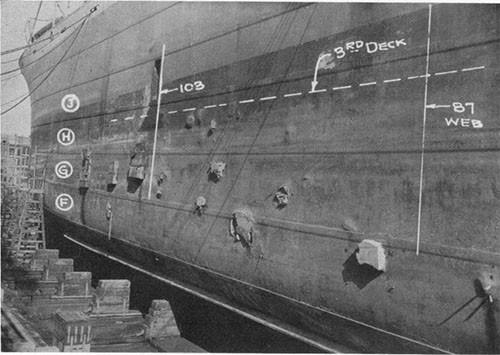
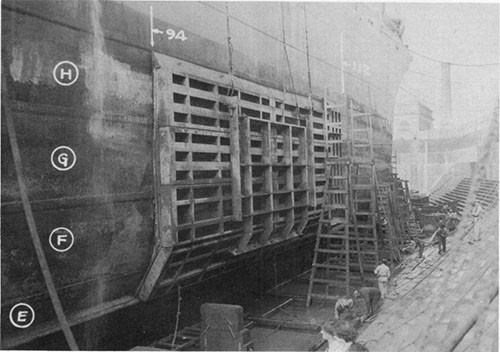
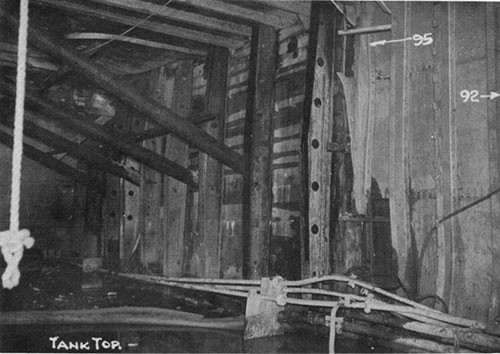
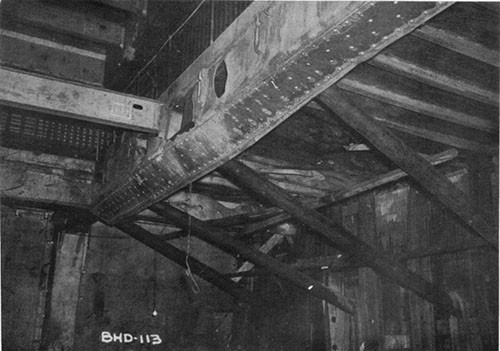
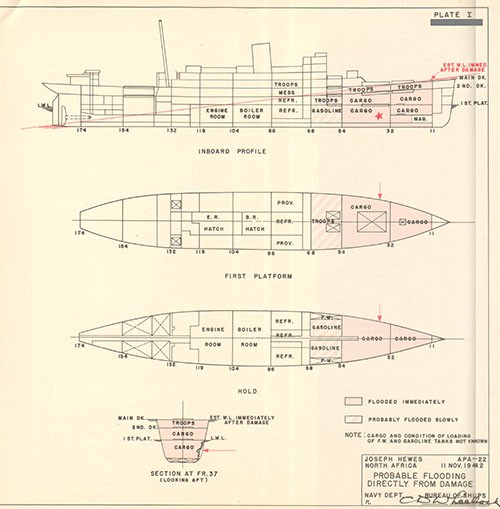
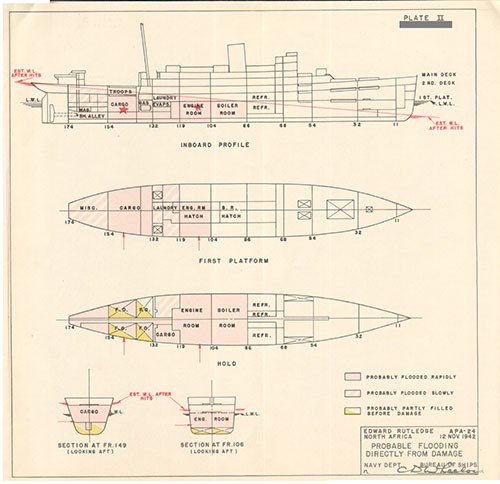
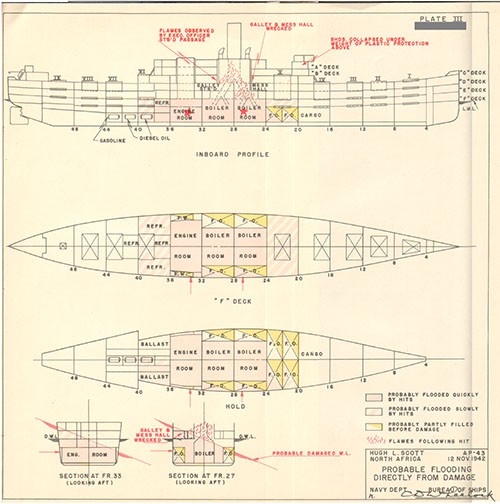
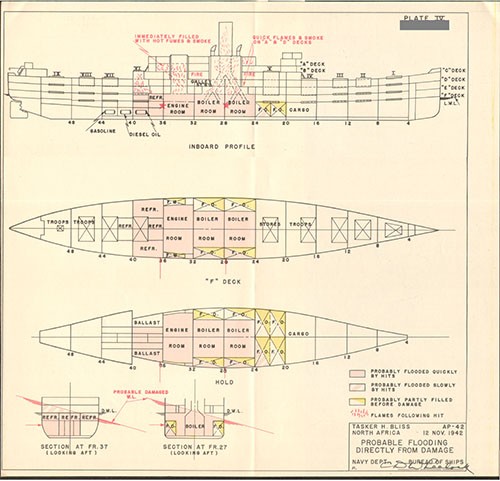
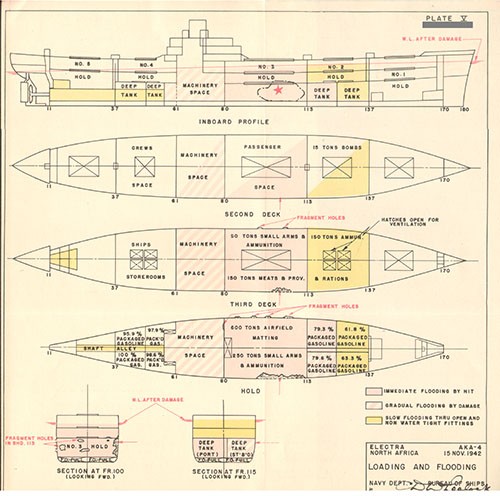
[END]



